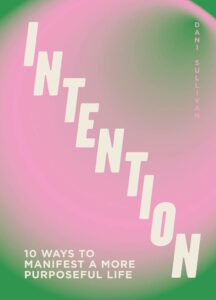 Extracted with permissions from ‘Intention; 10 Ways to Live Purposefully’
Extracted with permissions from ‘Intention; 10 Ways to Live Purposefully’
WHAT IS AN INTENTION?
An intention is what we want the most, what our heart would ask for if it could speak. The origin of the word “intention” comes from the verb “intend”:
Intend (verb)
From the Latin intendere with root words in “inwards” and ten “towards”; intendere means to “turn one’s attention”, “to strain in quest” and “to stretch out, extend towards”.
To “intend” is to move both inwards and towards.
To intend is to turn one’s attention inwards, to bring clarity to one’s focus, to listen in quest of something.
Intention (noun)
From the Latin intensio, “a stretching, exertion” or “effort to stretch outwards”. From the Latin intensionem, “the action of stretching and straining towards”.
An intention is a will, a wish, a purpose, or an aim. An intention is a movement towards something from our centre. Intentions come from inside us and they direct us forward in quest of what we want.
SEVEN STEPS TOWARDS INTENTIONAL LIVING:
1. Be present. Notice what it’s like to be alive.
2. Slow down. Pause. Be quiet.
3. In silence, listen inwardly.
4. Imagine what you want.
5. Stretch towards the centre of your desires by asking “why?”
6. Clarify what you intend. Bring your attention inward and toward your intention.
7. Act in accordance with your intention.
Intention-setting is simple, intentional living is a bit more complicated.
You must work towards your intentions. Work is a reality of life – you don’t get what you want without moving towards it. Follow these steps to live with intention and repeat daily.
THE INNER COMPASS
Your inner being is carrying a compass. This compass is simple: it acts like any old compass, it helps you to position yourself and locate where you are. Traditional compasses provide a sense of direction as we navigate through the Earth’s terrain. Your inner compass offers direction as you navigate your life.
On any journey you take, it is likely you will lose your way. When trying to find your way home, you must stop, pause at your current location and hold your compass level to get a sense of direction. Then you must use a map or any reference materials you have to geolocate yourself.
When we pause, we have time to rest. Rest is anything that connects our mind and body. In rest, we can look inwards and imagine our intentions. Tricia Hersey speaks of Rest as Resistance and imagination in her manifesto, which is included in the Further Reading list (page 190). Intention setting doesn’t happen without slowing down. You can’t read your inner compass without pausing.
The same way as the Earth has a natural geomagnetic field, we have our own field of inner energy. The Earth has a North and a South Pole. These opposite poles attract, they hold the Earth together. This geomagnetic field is one of the invisible forces holding our world together.
The magnetic needle in a traditional compass is suspended in liquid and responds to our movement and location as we travel. When we hold our compass level and pause to geolocate, we can identify the “magnetic north”.
The magnetic North Pole of Earth does not match up perfectly with our geographic North Pole, or what we call “true north”. The magnetic north is not stable or fixed, our northernmost magnetic point is always changing. What we know to be “north” moves around as our planet’s magnetic field warps over time. Some estimate that in the last century, the magnetic North Pole has moved nearly 965 kilometres (600 miles) towards Siberia. What beautiful, natural evidence of change.
I like to remember I am from this Earth. I am a part of nature, a form of complex life on planet Earth.
We all are, essentially, nature. So, in the same way the Earth has direction, energy and change, so too does my life.
To use a compass, you have to look up, down and all around to orient yourself to your world and environment. Knowing which direction is North and South is our map to returning home. Our inner compass is responding not to the North and South magnetic Poles but to our own perception of good and bad, right and wrong.
The needle in our compass points to our truth and our deepest values. The inner compass is a tool that truth seekers can use to find the light. We can use our inner compass to find our way home. We are here living, walking one another home.
The truth is something we can orient towards, reference and integrate, but we never get to “the pure, full truth”. This is because the truth is always changing.
The truth is complex and intersectional. Finding the truth is an individual and personal practice as much as it is a collective and communal need. Truth seeking isn’t about the destination. You don’t ever “get there” as long as you’re alive, you just learn more about what is true for you.
WHY SET INTENTIONS?
Intentions help us to read our inner compass. Essentially, they help us to define our truth.
Setting intentions is about aiming towards what you want for yourself. Without them, we can feel aimless, unsure of what we care about, or lacking in passion, resolve and will. Many feel lost, lonely, disconnected and unfocused.
Are you wandering around without aim?
When using a bow and arrow, you must pause first to focus on your target. Before you aim, you pull back on the bow, moving inwards. This inward movement is necessary for your arrow to fly with force towards its target.
If you want to reach your goals, you are going to have to look inside yourself. Try setting some intentions…
ARE YOU WANDERING AROUND WITHOUT AIM?
INTENTION SETTING FORMULA: WHAT WE WANT + WHAT WE NEED + WHAT WE WE DO
Ask yourself:
1. What do I want for myself?
2. What do I need to survive?
3. How can I move forward with my needs and desires in focus?
SET CLEAR INTENTIONS
An intention is a purpose, a mission statement, the “why” behind whatever we are doing. We all have the capacity to live our truth with intention.
Intention setting happens in the present. You can set intentions for everything and anything. You can clarify your intentions for the day, your work, a yoga class, your relationships with family and friends, even your next trip to the store. Intentions help us to aim in the right direction as we live our daily lives.
Intentions are deeply personal, there are no universal intentions. They are unique to each individual person – we all have different prayers and desires, and requests of life.
Consider what needs to be healed in your life and clarify your intention with these questions:
1. If you could change one thing about the world to make your existence more joyful, expansive, creative and lovely, what would you want to change?
2. What do you need in the present season of your life? How can you focus on your needs in a way that generates solutions?
3. If you had a magic wand and could ask for anything in the world, what would you want? How would you show up for your life if your wish came true?
How would you feel? What would you share?
4. Set an intention for your journey with this book. What do you want for yourself out of this guided experience?
INTENTION SETTING HAPPENS IN THE PRESENT
FOCUS – A LOST ART
“What should we focus on?”
This question causes many of my clients to squirm in their seats. Why? It gets straight to the heart of whatever they are needing help with. They’re not able to small talk or distract from what they need. Identifying a focus bypasses distractions and asks us to identify the heart of the matter. Focus is a necessity to get anything done with intentionality.
In this day and age, concentration has become a lost art. The amount of noise in our world is increasing as our technology and devices become more saturated with content and more difficult to put down. Distraction abounds. If you are easily distracted, forgetful and struggle with concentration, know you are in good company. Focus can be cultivated through practice and our experience of the world will shift if we learn to focus on what matters to us.
WHAT WE FOCUS ON EXPANDS
If you dedicated one hour per week to heal something, what would you focus on?
Intention setting requires us to have a positive focus on what we want, not what we lack. For example, “I don’t want to fail this test” is a worry (or a prayer for what we don’t want), whereas “I am smart and capable of acing this test” is an intention set with positivity.
Ask yourself:
• What does abundance look like for me?
• What practices help me to feel most connected to meaning?
• How do I define success?
• What brings me joy?
Complete these sentences:
I want more of this in my life: _________, __________ and ___________.
I would like my life to be _______________ and ________________.









Join the Discussion
Type out your comment here:
You must be logged in to post a comment.